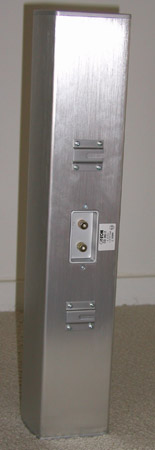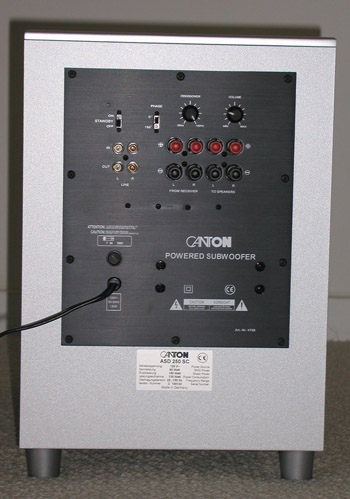Introduction
Flat screen displays (LCDs and Plasmas) are the hot item for watching TV
programs and movies. Declining prices have fueled demand. The market segment is large
enough that even the DLP and CRT camps are working hard to come up with slim
profile rear projection displays.
Following this trend are high-end loudspeaker companies
that are trying to create high-performance speakers that will
complement the aesthetics of such displays. Speakers of in-wall and on-wall
variety were abundant at the fall CEDIA show.
So how can floor-standing speakers get into the
fray?
Canton is one of the high-end companies that has embraced this market
segment with their CD series. We reviewed speakers from the CD 100 series a
while back. The CD 300 series is an attempt to push the performance
envelope even further, bringing the sonic performance closer to their
higher-end Karat and Ergo systems. Members of the 300 series are reviewed
here.
The Design
When I first unpacked the boxes the CD 300s came in, I was immediately struck
by their elegant modern look. The curved, brushed profile is really
something. It's very reflective, which some will like and others won't. The design
is obviously meant to
complement the look of flat-panel displays.
But looks are not all these
speakers are about. Lifting the speakers out of the box, I found out that
they were heavier than their size might have suggested. The build quality of
these speakers is excellent. Of course, looking at the price, you definitely
would expect them to be heavy, and I am glad to see that there is
substantive heft in spite of their diminutive appearance.
To improve the sonic performance of these speakers, Canton took the typical
approach of borrowing the driver technology from their higher-end designs.
The Canton AM-130 4-inch aluminum cone midrange/bass driver used in this
series is based on the midrange driver used in their Karat and Ergo speaker lines.
The cone, dust cap, and surround are modeled on the driver used in the Karat
Reference speaker. To accommodate the wide frequency range covered by these
drivers, the motor system has undergone a slight redesign. The
high-frequency duties are relegated to an advanced version of Canton's
ADT-25 tweeter. The 1" dome is made from an alloy of aluminum and manganese
which yields a structure that is both rigid and light (manganese is soft,
and the addition of this metal to the alloy reduces ringing in the driver).
 Both
the CD 300 and CD 360F share design principles and drivers. They both use
four AM-130 mid/bass drivers and a single ADT-25 tweeter. The
difference between the two speakers comes from the CD 300 being a
floor-standing bass reflex design, while the CD 360F is a wall-mountable
speaker in a sealed enclosure. The crossover on both speakers employs a 2 ½
way design. Signals below 400 Hz are routed to all four 4-inch drivers.
Midrange signals between 400 Hz and 3.3 kHz are only routed to the lower
pair of drivers. (In the case of the CD 360F, the lower pair corresponds to
the drivers located closest to the Canton logo). The asymmetric
configuration of the bass/midrange drivers is said to eliminate
cancellations in the midrange, allowing the CD 360F to be positioned either
horizontally or vertically.
Both
the CD 300 and CD 360F share design principles and drivers. They both use
four AM-130 mid/bass drivers and a single ADT-25 tweeter. The
difference between the two speakers comes from the CD 300 being a
floor-standing bass reflex design, while the CD 360F is a wall-mountable
speaker in a sealed enclosure. The crossover on both speakers employs a 2 ½
way design. Signals below 400 Hz are routed to all four 4-inch drivers.
Midrange signals between 400 Hz and 3.3 kHz are only routed to the lower
pair of drivers. (In the case of the CD 360F, the lower pair corresponds to
the drivers located closest to the Canton logo). The asymmetric
configuration of the bass/midrange drivers is said to eliminate
cancellations in the midrange, allowing the CD 360F to be positioned either
horizontally or vertically.
Speaker terminals for both speakers are located in a cavity on the back
panel. The terminals do not protrude out of this cavity. Banana plugs can be
used, although the tight spacing prevents the use of large spade connectors.
Wall-mounting brackets are supplied with the CD 360F as are fastening
base-plates for the CD 300, which without them are easy to tip over.
Canton does not offer any bipolar or dipolar designs in the CD series. For surround sound
speakers, one has the choice of using either the CD 300 or the CD 360F. For
this review, Canton sent me an additional pair of the CD 300s to use as
surround speakers. One can certainly experiment with directionality by
either aiming the speakers directly at the listener, or angling them towards
the rear wall, thereby getting more of the reflected sound. In
addition to the configuration as tested, other options would be to use three
CD 360Fs as on-wall LCRs (Left, Center, Right), or even a system of all
360Fs, plus subs.
 For
bass duties, Canton sent me a pair of their ASD 250 SC powered subwoofers.
This subwoofer features a downward firing driver in a ported enclosure.
Crossover is adjustable between 22 Hz and 150 Hz, and there is a two position phase switch (0 and 180 degrees),
along with the requisite volume control.
For
bass duties, Canton sent me a pair of their ASD 250 SC powered subwoofers.
This subwoofer features a downward firing driver in a ported enclosure.
Crossover is adjustable between 22 Hz and 150 Hz, and there is a two position phase switch (0 and 180 degrees),
along with the requisite volume control.
The subwoofer
can accept speaker-level inputs or line level-inputs. There is also a
corresponding set of speaker-level outputs and line-level outputs. The line
level inputs/outputs are stereo. The supplied Y-adaptor can be used to split
a mono subwoofer output to feed the line-level inputs. The
amplifier is rated at 80 watts RMS and 150 watts peak.
Setup
The CD 300 speakers have been optimized for near-wall placement. Canton's
literature recommends that they be placed somewhere between 4 and 20
inches from a wall. My own experiments with placement positions coincide
with Canton's recommendation. Placing the speakers any further made them
sound thin. Toeing-in the speakers proved to be slightly beneficial.
I used the CD 360F in center-channel duty. The speaker is meant to be
mounted on a wall (so you could use it as front left and right speakers at
the sides of the TV flat panel, and as a center channel speaker underneath), but, instead, I placed
it horizontally on a stand next to the wall. (Canton supplies the optional
TS 360F Table Stand for $100, an adjustable base that facilitates placement
on a shelf above or below a TV.) I positioned the two subwoofers
on each side-wall, about 11 feet into the room. I set the crossover
frequency to 80 Hz.
 Listening
Listening
My first exposure to the system was in two-channel mode with the CD 300s
set up as full-range speakers. It was immediately clear that these speakers
needed to be used in conjunction with a subwoofer. Adding a pair of the ASD 250 SC subwoofers filled in the gap left by the towers.
However, keep in mind that (1) the CD series is not designed to be full
range. They are designed to complement flat panel TVs, but still maintain
maximum performance within size constraints. Their slim profile
requires small drivers, which means that there will not be a lot of output
in the lowest two octaves. In other words, the CD series should not be
compared with all other speakers, as they are designed for a specific
application; (2) most other speakers also benefit from use of a subwoofer,
because they don't have much output in the lowest octave, particularly
around 20 Hz.
Listening to
this combination, the presentation from top to bottom was now well balanced.
Drums which had sounded thin now had more weight. Midrange on up, the sound
was smooth, and the imaging was very good. The treble was detailed without
any hint of brightness. Compared to my reference speakers, the Revel Ultima
Studios, I found these speakers to be a little shy on the airiness and
openness which can make the music sound big. In this case, the music sounded a little
closed-in. Depending on the room, putting them further from the wall or
changing the toe-in angle might help alleviate this.
Female vocals were reproduced with remarkable clarity. Listening
to Sarah Brightman's voice on “Time To Say Goodbye” was wonderful. Paul
Simon's vocals on “The Rhythm of the Saints” sounded really good as well.
Adding the center and surround speakers to the mix, I found this Canton
system to be very competent in performing surround sound duties. Dialogue
articulation through the CD 360F was very good. Hero was a delightful
movie to watch using this system. While I don't quite understand the language,
the dialogue came across as sounding clean and was not distracting. With
these monopole surrounds, I sometimes found myself wishing for a bit more
diffused sound that I would normally get from my reference dipole surrounds.
When watching the Spider-Man movies, pans across the speakers were smooth
and believable. The one thing I did notice was a slight elevation in the
upper-bass (every room will produce some particular peak with any set of
speakers). I was, however, able to fix this by engaging Room EQ on the MC12
V4 which I was using during this review. This also resulted in a slight
improvement in the clarity of the midrange. For those who may not have
access to something like Room EQ, other acoustic controls would be useful.
Given the proximity of these speakers to a boundary, such controls would
give the user the flexibility of tailoring the in-room response.
The low frequency reproduction capability of the ASD 250 SC subwoofers was quite good as well.
Playing the DTS release of the Blue Man Group's The Complex, the bass was
nice and tight. I did not hear any signs of compression even at reasonably
loud listening levels. This was probably the result of using two subwoofers
in my medium size room. The subwoofers did not have quite the same
low-level extension as my dual SVS CS-Ultra subwoofers, but they still
provided a satisfying experience, and have a much smaller profile.
The strength of this system was in its cohesive presentation. The use of the
same drivers and crossover made for excellent timbre matching. The recording
of Zephyr, an a cappella group, on AIX record's DVD-Audio Sampler is unique.
One of the mixes places the listener in the center of the group standing in
a circle. You feel like you are surrounded by the voices. The Canton system
did justice to this recording. No one speaker drew attention to itself,
resulting in a seamless blend across all the speakers.
Conclusions
With the introduction of the CD 300 series, Canton has produced an excellent surround-sound package that has visual appeal and sound quality
to match. They have designed these specifically for use with flat panel
displays, and taking into account the constraints that are necessary to have
them blend aesthetically with flat displays, they appear to have succeeded
in deriving the maximum sound quality possible.
In addition to complementing the flat-panel
displays, these speakers blend really well with modern furniture. The
mixture of floor- and wall-mounted options give the consumer the flexibility
to pick and choose what would work well in their environment. If you are in
the market for such speakers, definitely give this Canton system high
consideration. It will please both the eye and the ear!
- Sumit Chawla -
Associated Equipment:
DVD/CD playback: Panasonic RP-91
Amplifier: Proceed AMP5
Processor: Lexicon MC12 V4
Cables: BetterCables/Monster interconnects/speaker cables
Power: P600 Power Plant
Room: ASC Cinema Panels, ASC Iso-Wall